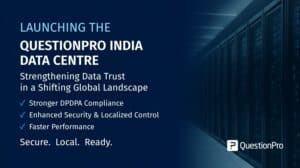
Web Surveys: Definition
Web surveys or internet surveys are defined as a data collection method where surveys or questionnaires are sent over the internet to a sample of respondents and they can respond to this survey over the world wide web. Respondents can be sent web surveys via various mediums such as email, embedded over the website, social media, etc. In web surveys, respondents answer the online questionnaire with the help of a web browser, and the survey responses are stored in web-based databases.
An example of an online web survey is a retail giant wanting to conduct a market research study about the purchasing habits of its customers. In this case, the customers can receive an email survey from the retail organization asking them to complete the survey. Other survey distribution methods can include SMS surveys, website embedding, social media, etc.
Organizations implement web surveys with the help of efficient web survey software in order to gain insights and feedback about upcoming products or services, changes in marketing strategies, enhancement in current features, etc. With the progress made by the internet, more and more organizations depend on the data received and analyzed from web surveys to make integral changes in their functioning.
The primary reason for the growth seen in the implementation of web surveys is that they are extremely low cost, and conducting a web survey is convenient due to the sheer magnitude of reach. Over the past decade, researchers have started preferring conducting surveys using online sources as they can send out surveys from desktops or laptops, and their target audience can respond to these surveys whenever possible. These surveys also allow the use of multimedia data collection and advanced features such as survey skip logic & branching, among others.
Characteristics of Web Surveys
There are four distinct characteristics of web surveys:
- Purpose of web survey: As with survey research, the purpose of the study has to be clearly defined, or the study will not do well at all, and you cannot make sense of the data that has been collected. Researchers should decide the objective of conducting a web survey so that the gauged results can be used to enhance products/services, customer service, or any other pre-decided objective.
- Research design: Research design will help market researchers decide how to collect information using web surveys and how to measure and analyze collected data. The type of research design can be decided according to the research problem an organization is facing. Upon detecting the research problem, a market researcher can decide from among various types of research design: Cross-sectional studies, longitudinal studies, experimental, correlational research, etc. In case an organization intends to conduct an online survey at a particular time, the researchers can rely on cross-sectional research design, and in situations where the organization wants to observe a change in pattern from a particular time interval to another, the researchers can rely on longitudinal research design.
- Creating a sample and data collection: A sample forms the next most important aspect of a web survey. Unless the sample is clearly defined, the data collection is irrelevant. Various sampling methods can be used for the most accurate data collection. In addition, using various question types helps to collect the most relevant data.
- Analysis and reporting: Data analysis is one of the most important parameters of web surveys. As long as the data that has been collected can be analyzed appropriately, it aids towards the relevance of the market research study.
Web Surveys: Methods & Types with Examples
Some of the most common methods of distributing web surveys with examples are as below:
- Email survey: One of the most commonly used methods to distribute a web survey is to email the survey. This email could go out as both an email blast to existing customers as well as prospective clients and customers. This method is one of the most effective ways of collecting survey responses. An example of distributing a web survey via email is a customer satisfaction survey that an organization can send out to its past and current customers in a bid to collect in-depth feedback on the satisfaction levels with the brand.
- SMS survey: Another effective method of web survey distribution is an SMS survey. This method of distribution is effective in the case of a very large set of contacts that are in one geographical location. This method can also be used in the case of needing to collect geo-location-based surveys where the phone number helps classify respondents. An example of an SMS survey is when a coffee store would like to understand the overall client satisfaction and would like to deploy a Net Promoter Score (NPS) question survey where the respondents can click on a URL in the text message and be taken to an online response platform.
- QR code integration: Web surveys can be converted into QR codes, which are then published either in print or online media. Using a smartphone enabled with a QR code reader, respondents can be directed to a web survey where they can record their responses. An example of this method of web survey distribution is a hardware product evaluation survey where the QR code is present as a print-out of the actual hardware.
- Social media integration: Posting a survey on social media channels such as Facebook, LinkedIn & Instagram is one of the most commonly used methods of distributing a web survey. This is also easy to accomplish, which typically happens with one click. An example of social media integration for web surveys is an airline service evaluation survey that an airline uses to collect feedback from passengers.
- Web intercept surveys: Another effective method of conducting web surveys is web-intercept surveys. This survey could be of multiple types – pop-up surveys, on-page surveys, exit surveys, and time-based surveys. The response rate of a web-intercept survey is high because of the non-intrusive method of data collection as well, and they have a high brand recall which increases the relevance of the responses. An example of this web survey method is an online retailer service evaluation survey where the respondent is shown a survey either on time spent browsing the website, making a purchase, or talking to a customer service executive.
The most effective way of collecting the maximum number of responses from a web survey is to use a mix of all the above methods depending on the demographics of the sample of respondents.
Examples of web surveys
- Customer surveys: One of the most commonly used types of web surveys are customer surveys and, more importantly – customer satisfaction surveys. These surveys help to collect in-depth feedback from customers about the organization and brand as well as its products and services. These web surveys also help collect actionable feedback about offerings to customers. A customer satisfaction (CSAT) survey and a service evaluation survey are two commonly used customer web surveys.
- Human resource surveys: Human resource web surveys are imperative to understanding the pulse of the workforce in an organization. In addition, they also help collect feedback from employees about stress, work-life balance, exit formalities, training initiatives, etc. Two frequently used human resource web surveys are an exit interview survey and a manager evaluation survey.
- Marketing surveys: Market research surveys or marketing surveys form a major chunk of web surveys. Organizations are constantly looking to collect feedback about new initiatives, offerings, and products. These surveys help collect holistic and intrinsic feedback on the competition and offerings as a whole. Some commonly used marketing web surveys are product registration survey and purchase process and evaluation survey.
- Industry surveys: These web surveys are used in a variety of industries such as healthcare, manufacturing, travel, retail, etc. These industry-specific web surveys help collect feedback from the industry in which the organization operates. Two commonly used industry web surveys are guest evaluation survey and airline evaluation survey.
- Community surveys: These web surveys provide you with optimized questionnaires to deliver the best community survey responses and insights. These web surveys include popular surveys such as community, demographic, psychographic, personal surveys and more. Two examples of community web surveys are life attitudes survey and compatibility test survey.
- Academic evaluation surveys: Another commonly used field of web surveys is academic evaluation surveys for schools, universities, and other educational institutions. These surveys help evaluate graduation, course evaluation, seminars, training and multiple other aspects in an educational institution. Two commonly used academic evaluation web surveys are course evaluation and improvement survey and University exit survey.
Advantages of Web Surveys
- Faster medium to reach the target audience: In comparison to other survey techniques, such as pen-and-paper surveys, web surveys are exceedingly fast in acquiring feedback from respondents.
- Real-time analysis: After collecting information, the analysis is an important step for researchers to take prompt actions. With the availability of web survey software such as QuestionPro, researchers can analyze collected data in real-time from a central dashboard.
- Cost-efficient: Due to the minimum required resources, web surveys are much cheaper than the other survey methods such as telephonic or pen-and-paper surveys.
- Minimum margin-of-error: Unlike the traditional survey methods, respondents directly answer the surveys, without the involvement of a mediator. The margin-of-error in case of web surveys is hence, very limited.
- Convenient to understand for respondents: Web surveys are usually very easy to answer as they either come to the email inbox or social media, it can be answered with a click.
- Saves researchers’ time: Web surveys are quick to configure and send and due to the ease, they tend to save researchers’ time.
- Respondents are more truthful: When a web survey is conducted within a target audience, researchers allow respondents to answer anonymously. Due to the anonymity involved in web surveys, respondents usually depict a more honest and truthful behavior in providing feedback.
Disadvantages of Web Surveys
- Respondent Cooperation Issues: Online users are usually bombarded with surveys, offers, and many other internet antics. There are chances that an important web survey can be overlooked or left unanswered.
- Questionable data reliability: Web surveys are conducted in the absence of a mediator or interviewer. Due to this absence, the feedback received, in many cases may be considered questionable.
- Limited access to certain sections of a population: There are sections of a target population which may not have access to the world wide web. In many cases, feedback from such individuals may prove to be effective for research. For example, if an NGO is conducting research to learn about the less fortunate people, it is highly unlikely that they have access to the internet which makes it difficult for researchers to collect data. However, the QuestionPro offline mobile app helps with field research as well as data collection where there is no access to the internet.
The success of any research is highly dependent on the web survey tool that is used for conducting the research.







